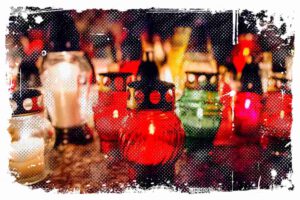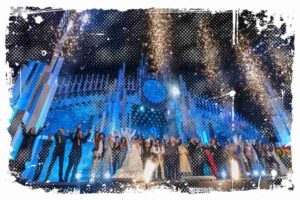Thinking about Advent time in Poland? Well, lets start with explanation that „Advent” has its roots in the Latin word „adventus”, meaning „coming”. This liturgical period is all about awaiting the arrival of the Savior. The first Sunday of Advent marks the beginning of the liturgical year in the Catholic Church and the Evangelical-Augsburg Church.
Before December even begins, you’ll notice festive decorations strewn all around the town. But this month also ties in with one of the church’s older traditions—Advent. This is the spiritual preparation leading up to Christmas. It’s a special time for Christians who celebrate the anticipation of Jesus’s birth. Like many traditions, Advent is full of customs that give it a unique character. Let’s see how Advent is celebrated in Poland.
Advent in Polish Tradition And it’s Meaning
Advent is a remarkable time for Christians. The first mentions of this time of waiting for Christmas date back to the 4th century, and by the 6th century in Rome, it evolved into a form that lasts for 4 weeks before the holidays. In the beginning, Advent was purely penitential. Today, however, it is often associated with a joyful period of anticipation.

The Start of Advent in Poland
Even though this liturgical period always ends on the same day each year, its beginning is movable. Advent 2020 kicked off on November 29th, the fourth Sunday before Christmas Eve, and wrapped up on December 24th.
↳ PRO TIP: Do you like traveling? Then before you buy any ticket or book an attraction, check if it's available in this worldwide Viator Database. You may save a lot of money and time. No need to thank me :)
The first Sunday of Advent starts a new liturgical year in the Christian Church. During Advent, the color purple dominates in liturgy, symbolizing a time of penance and preparation for Christmas—one of the most important Catholic holidays—and reconciliation with God and other people.
- I think you will also like: A Look into the History and Tradition of Candlemas Day in Poland
Now, if you want to dive deeper into this rich tradition, stay tuned for more insights. We will be exploring these rituals and the significance they hold for Polish Christians. As an observer or participant, knowing these traditions can offer a deeper understanding of the holiday season in Poland.
Announcing the Advent with Ligaws
In the northern regions of Mazowsze, Lubelszczyzna, and Podlasie, the arrival of Advent was announced through the play of ligaws. These were instruments shaped like long horns, over a meter in length, made from spruce or alder wood. The horn was made from two halves of a tree glued together and wrapped with root bindings.

The sound coming out of the horn was called „liganie”. To play this instrument, you needed particular physical attributes, mainly strong hands and robust, healthy lungs to make the horn vibrate. The resulting sound was a loud drone that could carry several kilometers away.
During World War II, the Germans occupying Podlasie believed the ligaws were a means of communication between partisans. To hinder this communication, they planned to execute the players.
I think it’s worth saying, the tradition of playing ligaws is alive to this day. Every year, the Ciechanowiecki National Competition of Playing Pastoral Instruments takes place, attracting enthusiasts from all over Poland.
Playing the ligaws was known as announcing the advent. It meant that after the wild celebrations of Andrzejki (St. Andrew’s Day), it was time for silence and penance. To maintain the required seriousness, musical instruments were locked away. On Wednesdays, Fridays, and Saturdays, fasting was required.
The common belief was that anyone not observing the fast wouldn’t see the Christmas star in the sky on Christmas Eve. As Oskar Kolberg wrote on the Tranowsko-Rzeszowska land,
Advent is a holy time. They do not drink vodka, do not eat meat, bacon, and on Wednesdays, Fridays, and Saturdays, they do not use butter or milk, which is replaced by oil. During Advent, they light candles on the roof for an early flax in March.
Roraty – The Advent Morning Masses
During Advent, morning masses known as Roraty were held in churches. The custom of attending these services was popular in Poland already in the Middle Ages. Families or neighbors would walk to the church together, singing religious songs along the way.

They carried lanterns that not only lit the path but also symbolized the biblical maidens waiting for the coming of Christ with collected oil and lamps. During the Roraty in Mazowsze, the musical accompaniment of the mass was provided by boys playing ligaws.
Until the Second Vatican Council, state Roraty were organized. On the various Sundays of Advent, priests gave teachings specifically aimed at unmarried women, married women, bachelors, and married men. This custom facilitated the faithful’s approach to the sacrament of penance.
Priests reminded the faithful that Advent was a special time for proper preparation for Christmas. For this reason, believers tried to do good deeds, avoid arguments and quarrels, maintain solemnity, and go to confession. It’s a tradition that carries forward to this day, and being there, you need to know these practices to fully appreciate the season.
- I am sure you will also like this article: Thanksgiving Traditions Around the World: Does Poland Celebrate?
The Advent Candle and Wreath
Listen up, folks! The most crucial symbol of Advent was the roratka – a white or blue wax candle tied with a ribbon. If you ever attended a mass during this period, you’d notice this candle lighting up the altar.

Why, you ask? It symbolized Mary, who brought the light of the world – Christ. Also, it is worth to say that in the 19th century, the tradition of the Advent wreath was borrowed from the Protestants.
This wreath, made of green branches with four candles in the middle, represented the four successive Advent Sundays. You could find these wreaths both in churches and in faithful homes.
Evenings of Feather Plucking and Social Gatherings
Girls returning from Mass enjoyed running up to bachelors and playfully shouting: „roracie, roracie, jak na imię macie?” (Rorate, Rorate, what’s your name?). Advent in the countryside was known as the wedding time – a time for matchmaking.
The pre-Christmas quiet period coincided with the rest after summer and autumn farming work. These long autumn evenings and early darkness were perfect for social gatherings.

Women gathered in houses over podskubki or wieczorynki – communal tearing of feathers, flax, and hemp. They would share stoiries about witches, demons, drowned ghosts, and vampires, lurking for wandering human souls.
Meanwhile, the boys, seeking fun, would sneak up to the girls’ houses and scare them by knocking on the window or shouting. More often than not, they would storm into the house dressed as devils or other frights, causing a commotion.
The boys would even release a cat or rooster, knocking over the girls’ gathered materials. These unusual courtship rituals were all in an attempt to attract attention and escort the girls home. It was not uncommon for these feather plucking sessions to turn into merry festivities.
Preparations from St. Lucy’s Day
From St. Lucy’s Day (December 13), the direct preparations for Christmas began. Gradually, the house was cleaned, and products for festive dishes were gathered. In Pomerania, caroling around the houses began precisely on this day.

Other Advent Customs
During Advent, people aimed to spend time together in the community. Especially among Protestants, they would read the Bible and the lives of saints in the family circle.
In the times of partitions, they would also read books by Henryk Sienkiewicz or dramas by Adam Mickiewicz and Juliusz Słowacki, aiming to maintain Polishness. Chiledren and young people participated in the preparation of Nativity plays and cribs.
In some Catholic parishes, they cultivated the tradition of the wandering figure of the Virgin Mary. A family whose child drew the lucky lot would receive the Mary figure for a day.
Family members would gather around her, singing religious songs and reciting prayers. The following day, the figure would be moved to another house. Quite a unique tradition, wouldn’t you say?

The Philip’s Fast
Orthodox believers observe a 40-day Post Filipowy or Philip’s Fast before Christmas, often referred to as the „winter Pascha„. This fast starts on November 28 – the day after the commemoration of St. Philip in the Orthodox Church. I think it is worth saying, it’s one of the four major fasts observed in the Orthodox liturgical year.
If you want to follow this tradition, you’ll need to adhere to some strict rules: no fish, meat, or dairy products can be consumed. Also, try to abstain from participating in loud parties. You’ll often find believers including these foods in their menus only from the second week of fasting.
Sundays of Holy Forefathers and Fathers
The two Sundays preceding Christmas, known as the Sundays of the Holy Forefathers and Fathers, hold a particular liturgical character. These are the days when all the significant figures of the Old Testament are remembered. This practice helps the faithful understand the history of humanity’s salvation.
However, I know Orthodox priests emphasize that in the Philip’s Fast, what’s more critical than abstinence from food is restraining from sin. Quite a different perspective, isn’t it?
References:
- https://adwent.pl/
- https://polskieradio.pl/39/156/artykul/2223757,adwent-w-polskiej-tradycji
- https://pl.wikipedia.org/wiki/Adwent



